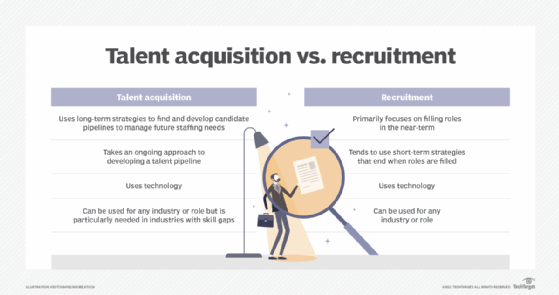How are recruitment and talent acquisition different?
Learn the difference between talent acquisition and recruiting, including the strategic implications each has for your organization and the technologies that help the most.
With the job market still showing the lingering effects of COVID-19, unemployment is near historic lows and workers are hard to find. Taking a reactive approach to talent acquisition in such a challenging climate can be risky.
Now more than ever, business and HR leaders need to be strategic and understand what sets up their talent acquisition strategy for success. Understanding the difference between recruiting and talent management and what goes into each one is essential.
The terms recruitment and talent acquisition are sometimes used synonymously, and both are part of talent management, a much broader discipline. Here's how to understand their differences and know when and how to apply each.
What is recruitment?
Recruitment is the process of finding, screening, hiring and eventually onboarding qualified job candidates. It is one of the most important HR functions and the biggest component of talent acquisition.
This article is part of
Ultimate guide to recruitment and talent acquisition
The process usually begins with a job requisition, a formal request to create or fill a position. Next comes a detailed job description, which is the basis for a job listing to be posted internally and on job boards or social media. The job listing adds language that explains the career opportunities and sells the organization.
When candidates apply, their applications and resumes are screened, sometimes automatically in applicant tracking system (ATS) software. Recruiters then use other screening methods, such as pre-hire personality tests, to learn more about candidates and assess their suitability for the role.
Hiring managers review this information and choose a finalist with whom they negotiate salary and benefits. A formal offer is sent. If the candidate accepts, onboarding begins.
What is talent acquisition?
Talent acquisition is a strategic process for identifying an organization's future staffing needs, especially executives, leaders and other highly skilled people, and applying the most effective tactics for finding, attracting, hiring and developing qualified candidates. Talent acquisition also involves analyzing the components of the hiring process and recommending changes to better align them with the organization's business goals.
Recruitment vs. talent acquisition
In essence, talent acquisition focuses on a strategic approach to developing a talent pipeline, which sometimes means developing and training current employees so they can take on different roles.
Recruitment, a subset of talent acquisition, focuses on filling an open position with the best possible candidate that is currently available. Here's a deeper dive into their differences.
Talent acquisition:
- uses long-term strategies to find and develop candidate pipelines to manage future staffing needs;
- is strategic and proactive;
- is a continuous, ongoing process;
- uses long-term strategies, such as employer branding and internal mobility, and technologies to support other strategies, such as candidate relationship management, data analytics, workforce segmentation and learning management systems; and
- can be used for any industry or role, but is particularly needed for hard-to-fill jobs in industries with talent shortages, such as medicine, manufacturing and IT.
Recruitment:
- seeks to attract, source and select candidates to fill specific vacancies in the short term;
- is reactive;
- is linear, with a specific endpoint;
- may rely solely on strategies to reach specific candidates, including job ads and technology to support sourcing such as ATSes; and
- can be used for any industry or role.

Is talent acquisition more valuable than recruitment?
Recruitment and talent acquisition are both important. Recruitment plays an important role in filling job openings and is the biggest subset of talent acquisition. However, because talent acquisition is more strategic, in the long term, its role is arguably more critical in facing the hardest challenges of the ever-changing job market, as well as in tackling more strategic priorities such as expanding into new lines of business, reducing costly turnover, bridging skills gaps and preparing the organization's workforce to meet future challenges.
When do you need to recruit?
Organizations need to recruit when a position opens or is expected to open, whether because a new role was created or because an employee left the job.
Tips for successful recruiting include the following:
- Craft the right job description.
- Source the appropriate candidate pool, both internally and externally, in ways that attract diverse candidates.
- Use the right technology such as an effective ATS.
- Refine recruitment marketing
- Provide a great candidate experience, including tailoring processes to candidates, such as using text-enabled interview scheduling.
- Use the organization's business goals to guide candidate selection and hiring and measure success.
When do you need talent acquisition?
Organizations need talent acquisition if they are in industries that have complex, new or hard-to-fill roles for which talent is in scarce supply. However, leaders in all kinds of organizations should consider taking a strategic and proactive approach to developing a talent pipeline.
How to switch from recruiting to talent acquisition
Because talent acquisition is a proactive, long-term approach, organizations need to make it a business priority that evolves and adapts to meet changing talent challenges. Here are seven best practices.
- Get top leadership buy-in. Until leaders understand the cost of reactive recruiting practices, they may not realize why investing in talent acquisition is worthwhile. Explaining the benefits of talent acquisition is a critical component of this. For example, achieving true diversity, equity and inclusion is unlikely without a proactive strategy.
- Create alignment throughout the organization. Everyone in the organization can play a role in supporting talent acquisition strategies, but they can only do so if goals are communicated clearly and include how each person can help.
- Empower talent acquisition leaders. Talent acquisition strategies should align with the mission, vision and values of an organization. They should be viewed as key drivers of an organization's success. Talent acquisition touches every part of an organization's value chain. As such, stakeholders from a variety of departments should have seats at the table.
- Invest enough resources to create success. Providing the time, materials and people needed to execute successfully on talent acquisition strategies is mandatory for success.
- Understand how internal mobility can support long-term goals. Cultivating top talent from within the organization can provide a cost-effective means of fulfilling talent acquisition goals.
- Use the right technology to support goals. In recent years, the HR technology market has exploded with new offerings, so it is easy to get distracted by the hype. Instead, business and HR leaders should rely on business goals and an understanding of the technologies currently in use to make decisions. Technology that talent acquisition leaders should explore includes the following:
- HR and people analytics;
- social media;
- video technology;
- workforce segmentation tools;
- ATSes with modern features such as texting capabilities;
- candidate relationship management systems;
- recruiting and talent development tools embedded with AI; and
- learning management systems and other internal mobility tools to support upskilling and reskilling.
- Don't forget agility. Even though talent acquisition is underpinned by a long-term strategic focus, there should be a solid understanding of how to respond to changing market conditions and disruptions, such as when COVID-19 hit and the focus on remote work became widespread.






